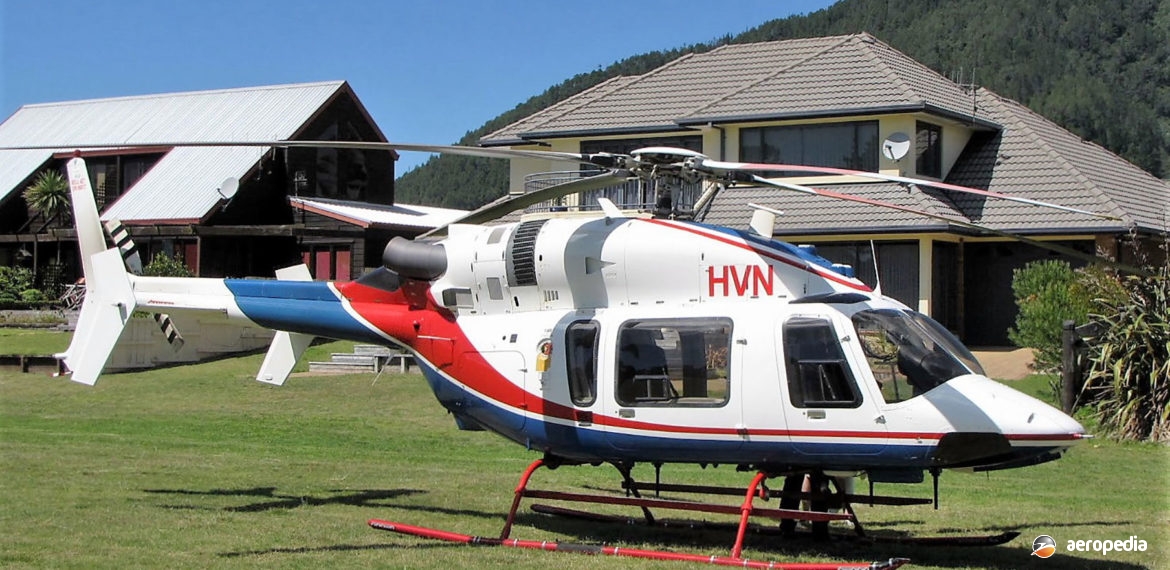Photograph:
Bell 427 ZK-HVN (c/n 56017) at Pauanui, NZ in March 2012 (NZCIVAIR)
Country of origin:
United States of America
Description:
General-purpose utility helicopter
Power Plant:
Two 456 kw (611 shp) Pratt & Whitney Canada PW206D turboshafts
Specifications:
- Fuselage length: 10.94 m (35 ft 11 in)
- Main rotor diameter: 11.28 m (37 ft)
- Height: 3.9 m (12 ft 8 in)
- Main rotor disc area: 99.9 m² (1,075.2 sq ft)
- Max cruising speed at sea level: 252 km/h (157 mph)
- Hovering ceiling in ground effect: 4,267 m (14,000 ft)
- Hovering ceiling out of ground effect: 3,200 m (10,500 ft)
- Range at sea level: 654 km (406 miles)
- Fuel capacity: 720 litres (158 Imp gals)
- Empty weight: 1,580 kg (3,485 lb)
- Useful load: 1,135 kg (2,502 lb)
- Loaded weight: 2,720 kg (6,000 lb)
History:
The Bell 427 was Bell Helicopter Textron’s first entry into the light twin-engined turbine utility helicopter market, being an eight-seat machine powered by two Pratt & Whitney Canada PW206D turboshafts. The Model 427 made its first flight in December 1997 at the Company’s facility at Mirabel in southern Quebec, Canada, and subsequently two prototypes and three production machines were used in the flight test programme. By 1999 certification had been received from the US FAA in Category A, gross weights testing being conducted up to 2,950 kg (6,504 lb). Performance increased during testing by changing from the PW206D turboshaft to the more powerful PW207D, the take-off rating thus increasing to 1,060 kw (1,420 shp) with a 497 kw (800 shp) transmission, providing better hot and high performance.
The PW207D engine had a max continuous rating of 465 kw (623 hp) as opposed to the PW206D’s 425 kw (569 shp), providing a cruising speed of 250 km/h (155 mph), a hover out of ground effect ceiling of 4,267 m (14,000 ft) and an increase in range to 700 km (435 miles). The Model 427 had 33 per cent fewer cabin components than the Model 407 and 40 per cent less transmission gears than the Model 430. Full authority digital control by Hamilton Standard provided protection against engine surge and rotor droop by maintaining constant RPM. The liquid-crystal display system was by Rogerson Kratos.
First of the series seen in this region was demonstrated at the Australian International Air Show at Avalon, VIC in 2005, later being sold to P & R Helicopters which used it for charter work, this machine seating eight and having leather upholstery, air conditioning, a telephone and a sound system.
An example became VH-JJS (c/n 56015) on 9 June 2005 to McIver Aviation Pty Ltd of Oatlands, NSW. Further examples have been imported, including VH-BDS (c/n 56069) and VH-YUZ (c/n 56059) registered to Flying Wombats Australia Pty Ltd of Marks Point, NSW on 19 and 21 February 2019 respectively.

